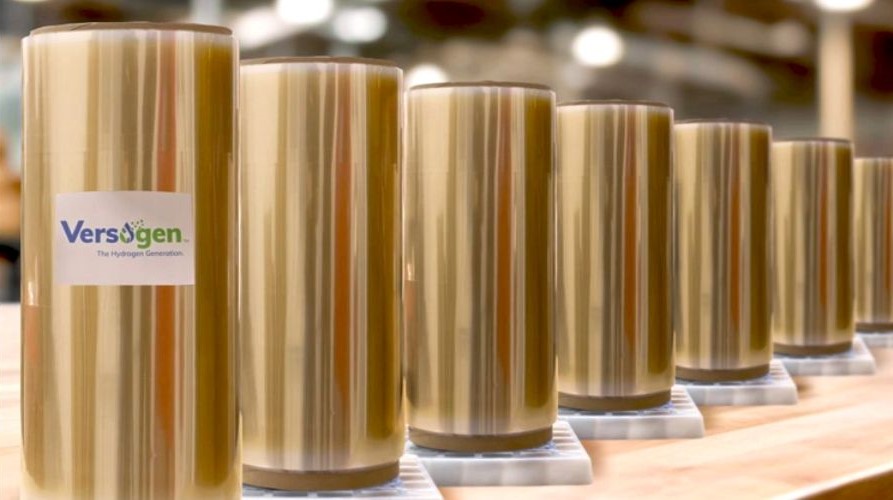Last week, Wilmington greentech company Versogen made a big announcement: It had achieved a major milestone by hitting a membrane production capacity of 1 gigawatt per year.
It’s a big deal in the green energy sector. But what does it actually mean?
Jim Prendergast joined Versogen in July as its sales and business development director. He has a way of breaking down the industry’s extremely technical language to explain the milestone in terms anyone can understand.
But first, a little background: We first got to know Versogen as W7Energy, a startup out of the University of Delaware founded by Yushan Yan (and 2020’s #1 RealLIST Startup for Delaware). The startup’s mission has always been to lower carbon emissions globally with its electrolyzers designed to create zero-emission green hydrogen.
What’s green hydrogen? It turns out that most of the hydrogen currently produced as a zero-carbon fuel actually creates carbon dioxide (CO2).
“The problem is the way that hydrogen is produced in the industry is using a process called ‘steam methane reforming,’” Prendergast told Technical.ly. “So basically they take methane and, with high-temperature steam, they crack the methane into the hydrogen that they need. The problem is, of course, what do they let go? CO2 — and this is a big problem.”
Less than 1% of the hydrogen made today is generated in an eco-friendly way. Versogen seeks to solve this problem with an electrolyzer system based around specially developed membranes that look like big spools of clear tape. The system uses these membranes to split water into hydrogen and oxygen without CO2 waste, thereby creating green hydrogen.
Why doesn’t everyone in the hydrogen energy economy use green hydrogen instead of the less eco-friendly steam-methane reforming hydrogen? Part of it is cost. Another reason is that these small startups all over the globe that have been developing ways to create green hydrogen are still figuring out how to scale it. So if the price falls, it becomes accessible and industries can truly start using it.
This brings us back to the news that Versogen achieved a membrane production capacity of 1 gigawatt per year.
“So, gigawatt is the input electricity that you need to split the water,” Prendergast said. “And we are making enough membrane now that we can support one full gigawatt of electrolyzer capacity, which — let me put it to you this way: If you look at the size of the projects that are typically out there today, they’re in the megawatt range. So we’re saying that we’re able to make enough membrane to support projects that are five to 10 times larger than what is being announced today. … We believe that the innovation here is that we’re one of the very first ones to make the claim that we’re able to make such large quantities of high-quality membrane for this up-and-coming technology.”
Basically, this news means that when it comes to larger energy projects that were previously too big to effectively use green hydrogen, Versogen can handle it.
That may be the biggest hydrogen news in Delaware since the US Department of Energy named the Mid-Atlantic Clean Hydrogen Hub (MACH2), a coalition of entities in Delaware, Southeastern Pennsylvania and South Jersey, one of seven Clean Energy Hubs across the country. As one might expect, Versogen is involved with the regional Hub.
“The hydrogen hub is not physically located in one area,” Prendergast said. “It’s in the Delaware Valley. And in the Delaware Valley, what we’re going to do is we’re going to match up all these interests, the producers, the consumers. But then, also, there’s a significant amount of workforce development that’s needed in Delaware so that people can have these good-paying jobs in these green industries. So we’re very involved in it. I’ve spent a fair amount of time on it, and we were actually listening to our elected leaders today reaffirm their commitment to it. it’s going to be a very exciting thing for our area.”
Versogen is in the process of a $4.8 million expansion announced in July 2022. The development will move the company from the Delaware Innovation Space to a larger space at FMC Stine Research Center in Newark. That move is creating at least 49 new engineering, manufacturing and executive jobs.
Before you go...
Please consider supporting Technical.ly to keep our independent journalism strong. Unlike most business-focused media outlets, we don’t have a paywall. Instead, we count on your personal and organizational support.
3 ways to support our work:- Contribute to the Journalism Fund. Charitable giving ensures our information remains free and accessible for residents to discover workforce programs and entrepreneurship pathways. This includes philanthropic grants and individual tax-deductible donations from readers like you.
- Use our Preferred Partners. Our directory of vetted providers offers high-quality recommendations for services our readers need, and each referral supports our journalism.
- Use our services. If you need entrepreneurs and tech leaders to buy your services, are seeking technologists to hire or want more professionals to know about your ecosystem, Technical.ly has the biggest and most engaged audience in the mid-Atlantic. We help companies tell their stories and answer big questions to meet and serve our community.
Join our growing Slack community
Join 5,000 tech professionals and entrepreneurs in our community Slack today!

The person charged in the UnitedHealthcare CEO shooting had a ton of tech connections

Delaware students take a field trip to China using their tablets and ChatGPT

From rejection to innovation: How I built a tool to beat AI hiring algorithms at their own game




